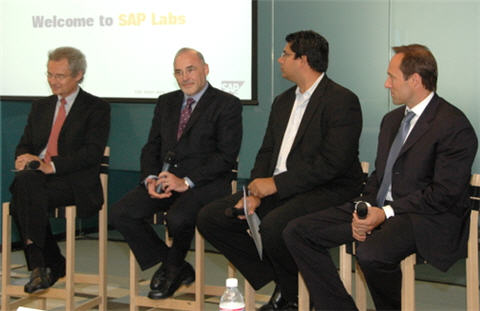SAP unveils Co-Innovation Lab and envisions Web 3.0

SAP held a dog and pony show, including a ribbon cutting ceremony, for the unveiling of its new Co-Innovation Lab in Palo Alto. "The intention is for this is to be a working lab, not just a slick showcase for customers," said Zia Yusef, executive vice president of the Global Ecosystem and Partner Group at SAP.

SAP and partners, including Cisco, HP, Intel and NetApp as well as ISVs and systems integrators, will work on joint projects and utilize a simulated, heterogeneous datacenter with hardware and software from participating vendors. The Co-Innovation Lab houses 1,600 SAP employees, including 1,000 engineers.
It's not exactly a keiretsu, but a compatible federation of companies that have a shared interest in building next-generation solutions, not just products, that integrate with SAP's ERP and NetWeaver platform.
"There is a constant demand from ISV partners to sit down with our developers and engage and imagine the future. We should not forget the human collaboration necessary to make innovation happen," Yusef said. For SAP, the Lab provides a showcase for its SOA-based platform and allows ISVs to test and demonstrate their products in a real world environment, and also highlight partner products.
"We want to bring partners in and show them that it is not 'marketechure,' " said SAP CEO Henning Kagermann. "Here, we can show much more variety. Before customers make a choice, they can see a variety of options, more than what they get from a reference site."
Kagermann also talked about proving to customers, via co-innovation, that there is no customer lock-in. "We are giving customers the freedom to choose," he said. "If others do it we appreciate it if they are successful. We are willing to compete on the best product."
SAP is being more open and global as a culture than in past decades, but the company fundamentally hopes to hook customers on its SOA platform. While it's not a formal lock in, once you make such a huge investment in a complex stack, feeling completely free is elusive.
A1S
During a Q&A after the announcement, SAP executives discussed the latest state of the new A1S on demand slated to ship next year. The company expects to reveal the real name of the product in the next few months, said Leo Apotheker, deputy CEO of SAP.
"The fact that we have announced A1s has had a positive effect. It shows that we are committed to the mid-market, and we have made it very clear with the first test customers. It addresses a totally untapped part of the market, so it is all net additional business," Apotheker said regarding whether A1S would cannibalize existing business.
When asked about comparison to salesforce.com, Kagermann said, "You cannot compare salesforce.com with A1S. It's just providing piece of CRM." He said that A1S, which could be currently classified as vaporware, is more complete, covering manufacturing, supply chain management, financials and other functions. "A1S is dedicated for the mid-market. We have to do it on demand to significantly lower TCO. It's not only a new product, but also a way go to market...you can only start with a radical approach and greenfield. You can't do that approach for HP," Kagermann said.
"We want to prove that we can run an entire business in an on-demand mode. No one has proven it so far. You have to select the right segment, and we felt the lower mid-market is the right segment. This fits better for business reasons--it's a $15 billion untapped market for SAP," Kagermann said. NetSuite has developed an on demand product that has more breadth than salesforce.com, covering ERP, CRM and ecommerc, and addresses the small and lower mid-market customers, but wasn't mentioned by the SAP team.
He reiterated his position that software-as-a-service is not the ultimate answer. "The answer is choice for the customer. You need a hybrid model so the customer has choice," he said. For on demand, SAP advocates isolated tenancy for customers who are concerned about sensitive data as well as multitenancy, where customers share server infrastructure. Using blade servers, SAP believes that it can deliver TCO similar to that of multitenant architectures via isolated tenancy.
Web 3.0
During his remarks, Kagermann discussed his notion of Web 3.0. "Web 2.0 is coming up in value. We want take Web 2.0 to 3.0." It's a version of the semantic Web theme, but focused on business software. "If you look to the services that we are defining with our enterprise SOA and things a bit beyond, we know that these type of enterprise services over time, in collaboration with many customers, associations and partners, a kind of standard can bring the Internet of business services," Kagermann said. "We don't have the semantics today that go beyond Web 2.0 and will allow software to to speak to each other."
I asked Vishal Sikka, CTO of SAP, for further detail about what Kagermann meant in his definition of Web 3.0.
"Thousands of services have emerged from our code base, and we have a good handle on what they mean. It gives us an opportunity to solve the problem of linking up interactions more automatically via semantics," he said. "We are working with groups at Stanford and in Germany. The next step of intra-company an inter-company integration is making service semantics more visible. I'm not implying automated integration any time soon, but we are seeing steps forward.
He also viewed Web 2.0 technologies, such as tagging, as another way to to build semantic knowledge from the ground up. Ultimately, standards for business service semantics,like RosettaNet, will be need to evolve.
Zia Yusef and Henning Kagermann cut the ribbon to formally open SAP's Co-Innovation Lab